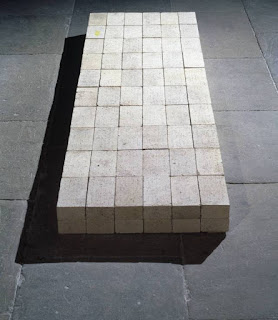Clearly context is crucial to the meaning and function of any work of art. Carl Andre's famous or infamous ( depending on your point of view) 'Equivalent VIII' more popularly referred to as 'The Tate Bricks' which caused such a controversy in the British press when it was exhibited for a second time at the Tate Gallery in 1976, owes much of its meaning to the fact that it was displayed in a gallery space and not on a building site - a principle of modernism that can be traced to Marcel Duchamp and his famous 'ready-mades'.
 |
| Marcel Duchamp 'Fountain' 1917 |
Andre's seminal minimalist aesthetic is clearly in retrospect historically significant and his visual influence is arguably evident in artists as similar and diverse as Sean Scully or Agnes Martin whose works are ostensibly concerned with regular patterns of equivalent units although this is perhaps only a superficial visual similarity.
 |
| Carl Andre. Equivalents VIII. Firebricks, 120-unit rectangular solid, 2 high x 6 header x 10 stretcher, 2 1/2 x 4 1/2 x 9 (6.4 x 11.4 x 22.9) each, 5 x 27 x 90 1/8 (12.8 x 68.5 x 229) |
'Although each of the eight shapes was different, they all
occupied the same amount of space in cubic centimetres, which accounted
for their visual equivalence. He therefore entitled this exhibition
Equivalents. ..........Andre added on 12 May 1972 that none of
these pieces was sold from the Tibor de Nagy exhibition and he
afterwards returned all but 200 of the bricks to the brickyard to get
his money back. The original bricks were sand-lime bricks from the Long
Island City Brickworks. When he decided to reconstruct the pieces
several years later he found that this brickworks had closed, so he used
firebricks instead. These are approximately the same size, but
yellowy-brown instead of bluish white.' (From the Tate Gallery catalogue entry.)
 |
| Untitled 1977 Agnes Martin American, 1938-2004 India ink, graphite, and gesso on canvas 72 x 72 inches |
 |
| Sean Scully, Wall of Light Burren 2003 Oil on linen, 75 x 85 inches, |
Sean Scully has documented in photographs and texts his interest in the patterns of dry stone walls on Aran or brick warehouse facades in New York and Agnes Martin was apparently a dab hand when it came to making the abobe walls of her residence in New Mexico. My own current preoccupation with patterns and brick owes as much to practical necessity as it does to aesthetics although the two are not easily separated. 'Shower' below is still waiting to have the glass panel installed before it is fully finished but it represents a significant step forward from the outside toilet it has replaced.
 |
| 'Shower'. media: ceramic tile, lime mortar, metal and plastic, size 200x160 x80 cm |
The reclaimed brick floor in a herringbone pattern is half finished. A remarkable number of these 17/18th century handmade bricks have the worker's finger marks baked into the clay, many of them quite small that suggests they were using child labour in the brick kilns to press-mold and stack them before and after firing. Now that the damp bricks are being used up the woodlice that came into the house with them and which I have been gently ejecting have started to leave. These benign little creatures do not damage sound wood or carry disease but they do like the damp corners which have almost all disappeared inside.
 |
| laying the bricks in lime mortar on the prepared lime slab and 'breathable' insulation layer. |
 |
| lunch break: cooking mushrooms and pasta on the stove using methelated spirits |
'P' salvaged the blue stone window sill in the bathroom and I lime mortared around it to create the profile.
I was also up the ladders again this time in the garden of the Hof Van Pittem to re-point the top of the party wall I share with my ecclesiastical neighbour. It would be very nice if I could open a small door under the stairs and access this lovely garden from the hall but this is pure fantasy! On the other side I have further brick repairs to make in the summer.
You can see clearly the staining and profile of an old 17th cen. or earlier bread kiln and chimney stack that occupied the corner of the terrace, the remains of which were discovered in the old storage space behind the outside toilet which was demolished last summer to enlarge the terrace and prepare for the rebuilding of the kitchen and bathroom. I plan to repair this section wall with lime mortar and the remaining old bricks.








No comments:
Post a Comment